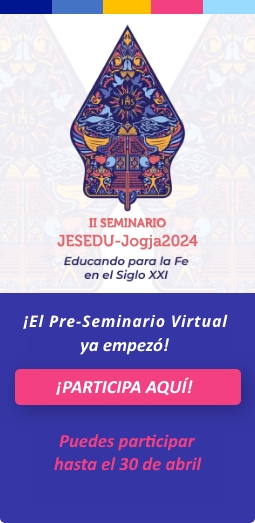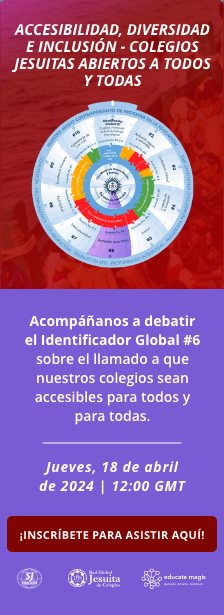When a student is in my class, is it evident to him that he is in a Jesuit school?
We strive to be more than a “good school”. We are Jesuit schools. What makes our schools “Jesuit” is centered about Mission and Identity. Should Mission and Identity be left to theology class, campus ministry and service? Is Mission and Identity simply cura personalis, a subtle way of proceeding through our interactions with our students and each other? Just as we as educators are working to bring our content out of the silos of the walls of our classroom, to bring our students to integrate, assimilate, live and apply it by giving back to the world, Mission and identity should not be siloed into only theology, campus ministry and service projects if we truly want our students to live out as true Men and Women For and With Others – grounded in faith, working for justice and evangelizing towards the Kingdom of God. Especially in today’s secular world with fewer and fewer practicing their faith and fewer and fewer Jesuits teaching in our schools, Mission and Identity should be intentional and evident throughout the curriculum. As teachers and parents know, the more exposure the better. Why think of only course content when it comes to “real world”, “cross-curricular”, “challenging” and “innovative”? The delivery of Our Mission, Our Catholic, Ignatian Identity, should also be “real world”, “integrative”, “challenging” and “innovative”.
So, I’m a high school biology and forensic science teacher with an academic and teaching background in science. I’m also a practicing Catholic who is happily married with 6 boys of our own, and I went to Catholic grade school, Catholic high school, Rockhurst College (University) and St. Louis University. Propagating the Mission and our Catholic faith are important to me, as both a parent and a teacher. But…I’m not a theology teacher. How does faith, justice and evangelization towards the Kingdom of God look in my biology classroom? How do I “sell” it? How do I get student to “buy in”?
When the students enter my room, they see crucifixes at the front and back of the classroom, posters of the Grad-At-Grad, Jesuits in Formation, God in All Things, news clippings on bioethical topics from The Review, the St. Louis Archdiocesan newspaper, and from the Jesuits magazine. We begin class with a daily prayer. What is going on in your life? At school? In St. Louis? In the world today? For whom do we need to pray? Is there a prayer that relates to course content? This helps me to know where my students are and helps to set the context for the day.
We delve into the lesson, and, for topics that transverse faith or bioethics, we meet it head on – contraception, abortion, stem cells, cloning, eugenics, genetic and reproductive technologies, euthanasia, evolution, environmental stewardship, unequal distribution of resources (food, water, medical care). We talk about the science, perceptions and misconceptions, and Catholic teaching (this year also the Universal Apostolic Preferences). For ALL students, regardless of whether they are Catholic and wherever they are with religion/spirituality, I ask them to reflect on their own faith/moral compass. I don’t tell them what to think as we all know how that will go over with teenagers. Rather my classroom becomes a safe space to allow “courageous conversations” to occur. Discussion happens either aloud in conversation or in digital forums to reflect on their values with these “hot topics” without preaching or condescension. Is it more important to know information or what to do with that information? The goal is that students not only know the concepts in the unit but by examining their beliefs they are confronted with making informed, faith-based decisions on bioethical issues which they may encounter in life.
These classroom conversations helped to develop a rapport with my students who felt comfortable discussing uncomfortable topics outside their class with me and even sought me out when they moved on as upperclassmen or alumni. My third year of teaching high school biology, an effervescent junior, Seamus, stopped me in the hallway while I was on the library. Seamus took my freshman bio class, and, as a junior, he was then taking Morality or Faith and Justice. “Hey, Doc!” He blurted out in the crowded hallway. “What do you think about premarital sex?” I, of course, was taken aback. I was looking to get some grading completed! He saw my expression and quickly rephrased, “I mean, you’re a biologist. Right? What would biology say about premarital sex?” Seamus followed me into the library, and we sat down. I figured this conversation required a seat. I thought for a moment (called on the Holy Spirit), and this is what came out: “Well, if you are asking what biology would say, biology says ‘do it’. Biology is the study of life, including animals. Animals are instinctual. So, if you are thinking of animals and sex, biology says ‘do it’ out of instinct. Think of people who act like animals. They are impulsive, act on every whim without thinking. If you are going to be human and not an animal, you’ll put a brake on it and think ‘is this okay?’ ‘is this alright?’ ‘do I respect this other person and myself?’ ‘does this fit in with my moral code?’ Seamus thought for a moment, then said “Yeah. I don’t believe in it either. I just wanted to hear what you thought.” (Whew!) Notice I never directly answered his question, and he arrived at his own conclusion. That was a defining Holy Spirit at Work moment for me. I use this story in my class when we cover reproduction. Parents appreciate that I don’t simply teach them the way things work, but I also include the ‘is this okay?’ part. At a Catholic, Jesuit school, it’s not enough to say ‘What’ and that ‘We Can’ – but we also need to address the How? Why? and Because We Can, Should We?
I also teach forensic science (the CSI kind). The subject matter makes it a bit easier to think about Committed to Justice, Loving and Religious. In the first unit about eyewitness accounts, we talk about the role of bias, how the mind works and the value of understanding different perspectives. When talking about jurisprudence, there ARE at least two sides to every story. Where is the other coming from? Students researched cases listed under the Missouri Innocence Project. Is there any way to compensate? How can this be avoided? What is Catholic teaching on terrorism? war? gun violence? capital punishment? Is there a time when killing is “justified”? Where is mercy in crime and punishment?
At the recent JSN Colloquium in Chicago I attended the session on “Ethics Across The Curriculum” which was packed. It was invigorating to see so many interested in wanting to incorporate ethics into their school. At the same time, as we introduced ourselves, it was interesting to see relatively few attendees outside of theology, counseling and campus ministry. Only two there were science instructors. Later in the week, I gave my own presentation on “Faith and Science: Friends, Not Foes! How Can “Religious” Look in a Science Classroom?” For whatever reason – competition of topics of interest to science faculty, deprioritization, discomfort or the misconception that faith and science need to be separate- only two were in attendance: two science teachers, one from California and a Jesuit from Canada (thank you for helping me not feel like a total loser!). It was a truly, fruitful Mission-science discussion with those two science faculty. I’m hoping more will get into the conversation!
Christ calls us To Know Him, To Love Him and To Serve Him. Innovative evangelization requires finding novel ways to reach our kids. Students want to be understood, heard, loved, supported and challenged (Panozzo 2018; Twenge 2017). How do we model and foster a path to the Kingdom of God? Help our kids understand God, themselves, each other and the world. Promote an environment of empathy and care. Guide them and challenge them to blend what they know, what they believe in, what they care about and call them to action in service.
Can you identify Mission and Identity in your classroom? Can your students? If students can see the Kingdom of God – faith, justice, hope, love – in every classroom, we can truly foster our Mission to help them lead a life beyond our school walls Grounded in Faith, Open, Loving and Committed to Justice- all aimed toward the Kingdom of God. How are you forming Men and Women For and With Others in your role at school?
For prayers, topics, lesson ideas and resources on how to incorporate Mission in a Science classroom click here
Other Resources:
Podcast of how teachers incorporate faith in science and science in faith in the classrooms (Dr. Baxendale’s interview is Episode 1)
Websites:
https://magiscenter.com/science-reason-faith/
https://faithscience.org/
Panozzo, P. 2018. Vanishing Young Catholics: Direct Feedback Supports National Surveys. Institute For Theological Encounter with Science and Technology (ITEST) Bulletin. 49 (2): pp. 3-6.
Twenge, J.M. 2017. iGen: Why today’s Super-connected Kids Are Growing Up Less Rebellious, More tolerant, Less happy-and Completely Unprepared for Adulthood (and What That Means for the Rest of Us). Atria Books, New York.
Inicia sesión o Hazte miembro
para crear y ver comentarios

